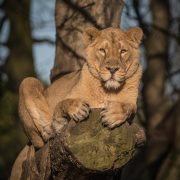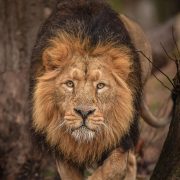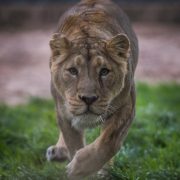We’re welcoming the lions into their NEW home this autumn!
This autumn, the lions are making the big move to their new habitat, which is specially designed to suit their every need and simulate their natural habitat.
Our lions are ASIATIC and are found only in a small area of India called Gir Forest, which is an area smaller than Greater London. They once roamed across Africa, Turkey and Asia, but there are now only a few hundred left in the world. Asiatic lions are endangered and are facing threats in the wild, including conflicts with growing human populations and poaching. One disease or natural disaster could wipe out this localised population. So we’re taking steps to prevent extinction of this majestic species.
Our lions are part of the European Endangered Species Breeding Programme which aims to conserve a healthy population of Asiatic lions across Europe. This creates a wider gene pool and also creates an insurance population should the species become extinct in the wild.
We sat down with Kieran Cieslinski, a member of the carnivore team, to find out more about our BRAND NEW Asiatic lion habitat and what visitors can expect…
“I’ve worked with our lions for just over 2 years now and I’m also part of the team responsible for caring for all the other cat, dog and bear species as well as a few other interesting animals like the giant otters and the fossa. No day is the same as a zoo keeper but it will usually be filled with a combination of tasks including spending time with the animals to check everyone is in good health, cleaning and maintaining their habitats, developing and implementing enrichment, and prepping food.
People most commonly associate lions with Africa, however our Lions are actually Asiatic lions and where as they once ranged across Asia into eastern India, they can now only be found within a 20,000km2-protected area of the Gir Forest in India. There are roughly 20,000 African lions left in the wild, and only several hundred Asiatic lions remaining. Both species of lion are visually similar so the confusion can be excused, however Asiatic lions are slightly smaller, they have a fold of skin that runs along there belly which African lions don’t have, and males tend to have a shorter darker mane compared to the fuller mane of an African lion!
Here at the zoo we have 3 lions; the male, Iblis, and 2 girls Kumari and her sister Kiburi. All of which are 12 years old now and have lived together at the zoo since 2011. I am frequently asked why we only have 3 lions in our pride and that is because Asiatic lions live in smaller prides containing 3 -5 members, and even then males are often nomadic and may only be present for mating and feeding. However the girls have strong family bonds and usually enjoy each other’s company, although they do occasionally need some alone time.
The current lion habitat is one of the oldest in the zoo, and with the zoo’s layout changing as part of the strategic development plan it made sense to move their habitat to a totally new location. The new habitat will give them much more space and will provide myself and the team with the opportunity to implement some new innovative enrichment and husbandry techniques.
I don’t want to ruin the surprise, but this habitat is exciting!! The house is much more modern; one den is roughly as big as the entire old indoor area, and there are four of them! And not only that, but they now have an even bigger on show den. But outside the paddock is vast and is filled with shrubbery and furnishings to replicate that of their natural habitat, with a few other features such as heated platforms and food zip lines just to keep things interesting. One of the things I’m most excited about though is the pond, as the lions have never had access to an open body of water before. From time to time we have to shut the lions out of the paddock for maintenance work, but now we will have the option to give them access to an additional outside holding area that will be filled with more enrichment and vegetation.
PSSSTT
This habit is designed to get our visitors as close to our lions as possible with an immersive feel which will allow visitors to gain a closer look into the lives of the lions. With fantastic new interpretation, hopefully visitors will pick up a few facts about why it is so important that we do everything possible to help save these incredible animals.
Moving 3 adult lions to a new location has a lot of risks, so preparation is paramount to a safe and stress-free journey. Due to the age of the old habitat we have had to have a brand new crating area built so that we can leave the crate which we will be used to transport the lions in place and allow the lions to become habituated to its presence and the routine of entering into it. For this though you need time and patience. So over the upcoming weeks we will be using positive reinforcement techniques to build the lions’ trust in this new scenario, so come game day, to them it will be just another day. We will separate them off and ask them individually to enter the crate, then transport them straight to the new habitat, where they will be released.
I’m hoping with this new habitat visitors will be able to engage with the lions like never before and hopefully develop a love for them that will make them want to join the fight to help save the Asiatic lion from extinction.”
Join our Zoo Rangers for a whole host of exciting activities to celebrate our Asiatic Lions moving in to their ROARSOME new home! Be prepared to find out some fabulous facts, look at some amazing artefacts, and listen to terrific talks.
Your zoo ADVENTURE starts right here! Plan your BEST DAY and explore Chester Zoo. There’s plenty to do – so make the most of your day out.



